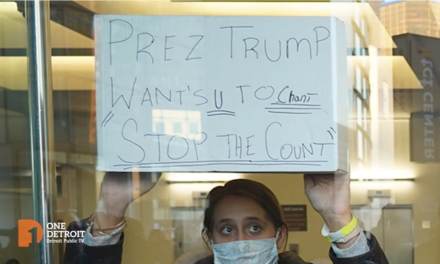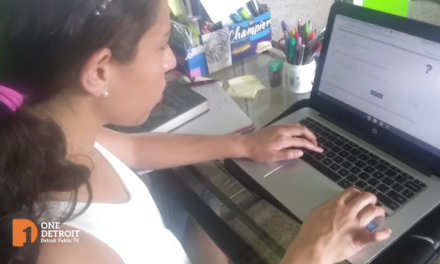An archive of oral history interviews with Japanese internment camp survivors found by Detroit documentary filmmaker Chien-An Yuan sparked an idea: how could these stories be creatively amplified to tell a new story, one reflective of the past and present day? That’s where the Asian American and Pacific Islander artists’ collective IS/LAND, of which Yuan is a collaborator, came in.
Together they created a new collaboration titled “Invisible Embrace,” to create a space and experience that allows audiences to share, learn and reflect on the experiences of Japanese internment camp survivors. A performance of “Invisible Embrace” can be seen at the Ann Arbor Public Library in October.
One Detroit Arts & Culture producer Sarah Smith sat down with Amber Kao, a mover and creative collaborator on “Invisible Embrace” with IS/LAND, to talk about the unique sound mechanics used, how recent waves of anti-Asian hate reflect the survivors’ stories, and what they hope audiences take away from the performance.

IS/LAND “Invisible Embrace” performers peel oranges on stage as a part of the performance. | Photo by One Detroit
Full Transcript:
Amber Koa, Mover & Collaborator, Is/Land: I think art is unique, in that, it is an automatic platform. Art offers that space and opportunity to bring awareness. IS/LAND is, essentially, a collective of Asian-American artists. There are movers, poets, digital designers, musicians. We love to collaborate with different facets of art and design. The collaborators for “Invisible Embrace” we worked with, there are three dancers, so, myself, and then, Chih-Hsien Lin and Catherine Hepler, and the sound installation was by, Juan Park and the music and set design was by Chien-An Yuan. What kind of pushed us into this space of “Invisible Embrace,” it was actually just very unexpectedly. We came across an archive of oral life history interviews with Japanese-American internment survivors.
Chien is our music director, set designer, and he found these oral interviews. This did stem from, you know, there was a lot of Asian hate crimes going on at the time and, you know, it just really resonated, I think, with him and with myself, once he shared it with us. Their history, their stories, how they are survivors, their trauma, and just their willingness and openness to share that through their interviews, and, you know, we were just saying we got to use this somehow. So, we decided to kind of use that as our focal point.
Juan Park, another one of our collaborators, he is, I would say, a sound innovator. His theories are that there is sound in the air, sound in the space that we cannot hear. But it takes the correct pickups, the correct instruments to draw out of the air. So, we wanted to incorporate that, and that, you know, these stories are there, you know, whether we see them or not, they’re always here. And we wanted, the act of drawing them out, is what we wanted to incorporate into our piece.
So there was a pickup and there are copper wires. And so, we were using these stories, these interviews, and we are running them through the wires and then the pickups we would manipulate the pickups, so if they’re in a close enough distance, these stories would be heard. But if you’re far away from the pickup and the wire, if they’re too far away, you won’t hear anything. And I think it’s reflective of how, you know, these stories are there. But you have to be intentional to listen and hear and, you know, to really process all of it.
Part of the movement that we were exploring were movements of rituals because rituals tie us back to heritage and culture. They give us a routine, stability, and they help us process things. So, we were just thinking about our own rituals and how that ties us back to our family, and then, that brought us into memories. You’ll see a cloth where, that kind of resembles, to me anyways, how we’re all kind of tied together. It’s a very long piece of cloth, maybe 50 feet, I want to say, even, maybe even longer, and it’s also very heavy. So, our stories are all entwined together in this cloth in some way, shape or form. And for me, fruit is a part of my family and how my dad always prepares and cuts the fruit for us. And so, we were peeling oranges on stage and so that became a ritual. Of course, then the scent became part of the process as well as it unfolded throughout the dance piece.
We’re creating a space in experience. And so, that in itself offers a platform to share. And so, that’s part of what we are hoping to do, is to invite people into a space where they can engage, they can reflect and they can take away something. I think that what we try to offer is an invitation to a dialog, an invitation for reflection.
We really resonated with this story; we hope you do, too. And so, I think maybe if anything, that would be the takeaway, is that they can be connected somehow, and that they are engaged somehow, and they have an experience that they’ll walk away with, that they’ll remember or, you know, want to explore more or want to enter a dialog into in the future, with us, with other people, with themselves, you know. So, all those things, I think that would be our ultimate goal, if we ever had one for our audience.
Stay Connected:
Subscribe to One Detroit’s YouTube Channel & Don’t miss One Detroit Mondays and Thursdays at 7:30 p.m. on Detroit Public TV, WTVS-Channel 56.
Catch the daily conversations on our website, Facebook, Twitter @DPTVOneDetroit, and Instagram @One.Detroit
View Past Episodes >
Watch One Detroit every Monday and Thursday at 7:30 p.m. ET on Detroit Public TV on Detroit Public TV, WTVS-Channel 56.




